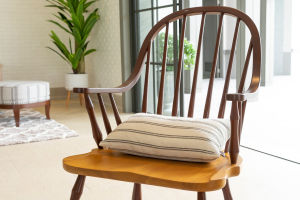
Vintage Vibes

A vinyl record player is a traditional audio playback device used for playing vinyl records.
It holds a classic status in the realm of audio equipment, offering unique sound quality and a nostalgic, retro charm.
1. Structure and Working Principle
A vinyl record player consists of several essential components:
Turntable: The turntable serves as the platform on which the record is played. It's typically constructed from metal or plastic and features a mount for the stylus. Turntables rotate at speeds such as 33 1/3 RPM, 45 RPM, or 78 RPM, which correspond to different types of records.
Tonearm: The tonearm supports the stylus (needle) and facilitates its movement across the record's surface. The design of the tonearm is crucial, requiring proper balance to ensure smooth contact with the record's grooves.
Related
 Chair: The art of seating that combines aesthetics and function.
Chair: The art of seating that combines aesthetics and function.
 Choosing the right essential oil requires consideration of several factors, including its purpose, personal preference, and more.
Choosing the right essential oil requires consideration of several factors, including its purpose, personal preference, and more.
 The small and fresh decoration style of the Mori Department can bring us joy and satisfaction.
The small and fresh decoration style of the Mori Department can bring us joy and satisfaction.
 RV travel is a unique and free way to travel.
RV travel is a unique and free way to travel.
 In Japan, flower culture plays an important role, and you can appreciate the perfect combination of beauty and art of flowers.
In Japan, flower culture plays an important role, and you can appreciate the perfect combination of beauty and art of flowers.
 RV: Your Home on Wheels, Packed with Comfort and Adventure-Ready Gear!
RV: Your Home on Wheels, Packed with Comfort and Adventure-Ready Gear!
Stylus: The stylus is a core component responsible for reading the audio information encoded on the record. It's usually crafted from materials like steel wire or carbon fiber, possessing exceptional precision.
As the turntable spins, the stylus navigates the grooves of the record, translating the groove information into an electrical audio signal.
Speakers: Turntables often require external speakers to amplify the audio signal and make it audible. These speakers are typically connected to the turntable through an amplifier, ensuring clear and pleasing sound quality.
The working principle of a vinyl record player involves the stylus reading the groove information on the record, converting it into a weak electrical signal.
This signal undergoes processes such as amplification and decoding, ultimately becoming an audible audio signal. This mechanical reading method imparts the vinyl record player with its unique sound quality, endearing it to countless music enthusiasts.
2. Advantages
Turntables possess distinctive advantages when compared to digital audio players and CD players:
Sound Quality: Turntables deliver warm and rich sound quality, showcasing greater audio detail and a natural sound. Many consider this sound quality to be more emotionally resonant and expressive than digital audio.

Vintage Charm: The vintage aesthetics and mechanical operation of a turntable appeal to many, imbuing it with sentimental value as a cherished piece of audio equipment.
Collectible Value: Rare vinyl records have become treasured items pursued by music collectors, and turntables are essential for playing these precious records.
Leisurely Enjoyment: Using a vinyl record player requires patience, encompassing steps like carefully placing the record and gently lowering the stylus. This leisurely pace allows people to fully savor the music and escape the fast-paced nature of modern life.
3. How to Use
Using a vinyl record player involves some basic operating skills. Here are simple steps for using it:
Placing the Record: Gently place the record on the turntable, ensuring it lies flat and the center hole aligns with the central axis of the turntable.
Lowering the Stylus: Carefully move the tonearm over the record, then gently lower the stylus. Avoid touching the record's surface while lowering the stylus to prevent scratches or damage.
Adjusting Sound Quality: Tailor the sound quality to your preferences and the record's characteristics. You can adjust parameters such as volume, bass, and treble to achieve the best sound quality.
After the Record: When the record finishes playing, the tonearm will automatically lift. You can then remove the record and turn off the record player.
In summary, the vinyl record player, as an ancient yet charming audio device, not only allows people to relive the musical styles of the past but also holds unique value in modern society. Its distinctive sound quality and nostalgic appeal continue to captivate music lovers and collectors alike.